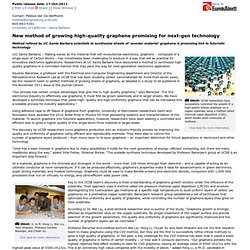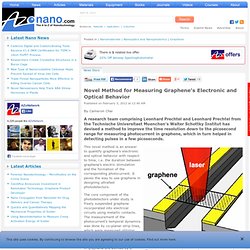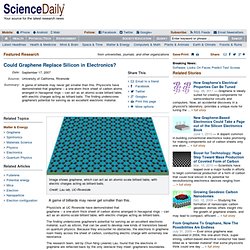

Graphene acts as plasmonic antenna, leads towards 0.1nm wires in chips. Are you sick of graphene-related breakthroughs yet?

No? Excellent! That’s good news because I’m about to write the coolest, sexiest, most scientific sentence you’ll ever see on ExtremeTech. A team of researchers from the Department of Energy’s Oak Ridge National Laboratory (ORNL) has shown that single-atom silicon defects in sheets of graphene act like atomic antennae, turning graphene into a plasmonic device capable of converting optical signals into electronic signals and vice versa.
Was that as good for you as it was for me? This isn’t a “wire” in the usual sense, though: it’s a plasmonic device. As far as applications for this discovery go, we’re really treading along the bleeding edge. Also along the same lines, plasmons have been used — in a lab setting — to perform very high resolution lithography and microscopy. Read more at ScienceDaily. Graphene : the futuristic element..... New method of growing high-quality graphene promising for next-gen technology. Public release date: 17-Oct-2011 [ Print | E-mail Share ] [ Close Window ] Contact: Melissa Van De Werfhorstmelissa@engineering.ucsb.edu 805-893-4301University of California - Santa Barbara (UC Santa Barbara) – Making waves as the material that will revolutionize electronics, graphene – composed of a single layer of Carbon atoms – has nonetheless been challenging to produce in a way that will be practical for innovative electronics applications.

Researchers at UC Santa Barbara have discovered a method to synthesize high quality graphene in a controlled manner that may pave the way for next-generation electronics application. "Our process has certain unique advantages that give rise to high quality graphene," says Banerjee. Novel Method for Measuring Graphene’s Electronic and Optical Behavior. By Cameron Chai Photodetectors made from graphene can process and conduct light signals as well as electric signals extremely fast.

Within picoseconds the optical stimulation of graphene generates a photocurrent. Until now, none of the available methods were fast enough to measure these processes in graphene. Scientists at the Technische Universitaet Muenchen now developed a method to measure the temporal dynamics of this photo current. Furthermore they discovered that graphene can emit terahertz radiation. This novel method is an answer to quantify graphene’s electronic and optical behavior with respect to time, i.e. the duration between graphene’s electric stimulation and the formation of the corresponding photocurrent. The core component of the photodetectors under study is freely suspended graphene incorporated into electrical circuits using metallic contacts.
Through this technique, the researchers accurately monitored the mechanism of photocurrent generation in graphene. Hot nickel nudges graphene: Rice University lab simplifies manufacture of semiconducting bilayer graphene" Home > Press > Hot nickel nudges graphene: Rice University lab simplifies manufacture of semiconducting bilayer graphene Abstract: By heating metal to make graphene, Rice University researchers may warm the hearts of high-tech electronics manufacturers.
Houston, TX | Posted on September 15th, 2011 The lab of Rice chemist James Tour published two papers this month that advance the science of making high-quality, bilayer graphene. They show how to grow it on a functional substrate by first having it diffuse into a layer of nickel. University. Advanced Composites Centre for Innovation and Science. Sweet way to make graphene – just add table sugar. There’s no doubt that the discovery of graphene is one sweet breakthrough.

The remarkable material offers everything from faster, cooler electronics and cheaper lithium-ion batteries to faster DNA sequencing and single-atom transistors. Researchers at Rice University have made graphene even sweeter by developing a way to make pristine sheets of the one-atom-thick form of carbon from plain table sugar and other carbon-based substances. In another plus, the one-step process takes place at temperatures low enough to make the wonder material easy to manufacture.
Physics Nobel Honors Work on Ultra-Thin Carbon. Carbon Wonderland. Consider the humble pencil.

It may come as a surprise to learn that the now common writing instrument at one time topped the list of must-have, high-tech gadgets. In fact, the simple pencil was once even banned from export as a strategic military asset. But what is probably more unexpected is the news that every time someone scribes a line with a pencil, the resulting mark includes bits of the hottest new material in physics and nanotechnology: graphene. Graphene comes from graphite, the “lead” in a pencil: a kind of pure carbon formed from flat, stacked layers of atoms.
The tiered structure of graphite was discerned centuries ago, and so it was natural for physicists and materials scientists to try splitting the mineral into its constituent sheets—if only to study a substance whose geometry might turn out to be so elegantly simple. Select an option below: Onnes.ph.man.ac.uk/nano/Publications/Naturemat_2007Review.pdf. Konstantin Novoselov Interview - Special Topic of Graphene - ScienceWatch.com. In Essential Science IndicatorsSM from Thomson Reuters, Dr.

Novoselov's record includes 49 papers, largely classified in Physics and Materials Science, cited 3,536 times between January 1, 1998 and October 31, 2008. Dr. Graphene - 2010 Nobel Prize in Physics. Graphene Vs Silicon. The graphene is a substance which has a single-layer crystal lattice of carbon atoms, which is unusual since it is different from all of the materials of its kind.

Several researchers have identified a way of making this substance, which allows them to use it in various fields and especially for the high-speed electronic devices. Graphene Definition: Graphene is defined as a one atom thin sheet of carbon atoms arranged in a Hexagonal format or a flat monolayer of carbon atoms that are tightly packed into a 2D honeycomb lattice. History: In October 2010, two University of Manchester (U.K.) scientists, Andre Geim and Konstantin Novolselov, were awarded the 2010 Nobel Prize in physics for their research on graphene. The Nobel Prize in Physics 2010. Could Graphene Replace Silicon in Electronics? A game of billiards may never get smaller than this.

Physicists at UC Riverside have demonstrated that graphene -- a one-atom thick sheet of carbon atoms arranged in hexagonal rings -- can act as an atomic-scale billiard table, with electric charges acting as billiard balls. The finding underscores graphene's potential for serving as an excellent electronic material, such as silicon, that can be used to develop new kinds of transistors based on quantum physics. Because they encounter no obstacles, the electrons in graphene roam freely across the sheet of carbon, conducting electric charge with extremely low resistance. The research team, led by Chun Ning (Jeanie) Lau, found that the electrons in graphene are reflected back by the only obstacle they meet: graphene's boundaries. "These electrons meet no other obstacles and behave like quantum billiard balls," said Lau, an assistant professor who joined UCR's Department of Physics and Astronomy in 2004. Google Image Result for.
The World's Strongest Stuff. By Melissa Salpietra Posted 11.24.10 NOVA Ask a materials scientist to choose the strongest material, and you are likely to get a question instead of an answer.

Allotropy. Diamond and graphite are two allotropes of carbon: pure forms of the same element that differ in crystalline structure. For some elements, allotropes have different molecular formulae which can persist in different phases – for example, two allotropes of oxygen (dioxygen, O2, and ozone, O3), can both exist in the solid, liquid and gaseous states. Conversely, some elements do not maintain distinct allotropes in different phases – for example phosphorus has numerous solid allotropes, which all revert to the same P4 form when melted to the liquid state. History[edit] Google Image Result for. Characterizing Graphene, Graphite, and Carbon Nanotubes by Raman Spectroscopy - Annual Review of Condensed Matter Physics, 1(1):89. Google Image Result for. Micro-Autonomous Flying Robot Powered by Solar Cells Under Development at University of New Mexico. Animated drawing for the autonomous flying system (COMBAT), showing the solar cells on the wing.
Lightweight, Flexible Thin Film QD Solar Cells for Micro-Autonomous Systems Technology (MAST) Applications have been developed at the University of New Mexico (Albuquerque, NM) by the Luke Lester Optoelectronics Group. Dr. Lester is a Professor in the Department of Electrical and Computer Engineering, the Microelectronics Endowed Chair Professor, General Chair of the Optical Science and Engineering Graduate Program, and Graduate Director of ECE. The goal there is to study thin film solar cells, which can be attached to a micro-autonomous flying robot (COMBAT) for power generation. Therefore, watt/g has become a parameter of interest because weight becomes an important factor during flight and most importantly at liftoff.
Advantages for using DWELL flexible solar cells include: · Increase efficiency 2.5X over existing thin-film amorphous silicon. Fullerene. The discovery of fullerenes greatly expanded the number of known carbon allotropes, which until recently were limited to graphite, diamond, and amorphous carbon such as soot and charcoal. Buckyballs and buckytubes have been the subject of intense research, both for their unique chemistry and for their technological applications, especially in materials science, electronics, and nanotechnology. History[edit] The icosahedral fullerene C540, another member of the family of fullerenes. Aromaticity. In organic chemistry, aromaticity is a chemical property describing the way in which a conjugated ring of unsaturated bonds, lone pairs, or empty orbitals exhibits a stabilization stronger than would be expected by the stabilization of conjugation alone. The earliest use of the term was in an article by August Wilhelm Hofmann in 1855.[1] There is no general relationship between aromaticity as a chemical property and the olfactory properties of such compounds.
Theory[edit] A better representation is that of the circular π bond (Armstrong's inner cycle), in which the electron density is evenly distributed through a π-bond above and below the ring. This model more correctly represents the location of electron density within the aromatic ring. The single bonds are formed with electrons in line between the carbon nuclei — these are called σ-bonds.
Since they are out of the plane of the atoms, these orbitals can interact with each other freely, and become delocalized. History[edit] Graphene. High-quality graphene is strong, light, nearly transparent and an excellent conductor of heat and electricity. Its interactions with other materials and with light and its inherently two-dimensional nature produce unique properties, such as the bipolar transistor effect, ballistic transport of charges and large quantum oscillations.
Search results. Ftp/arxiv/papers/0808/0808.3320.pdf. Graphite oxide. Graphite oxide, formerly called graphitic oxide or graphitic acid, is a compound of carbon, oxygen, and hydrogen in variable ratios, obtained by treating graphite with strong oxidizers. The maximally oxidized bulk product is a yellow solid with C:O ratio between 2.1 and 2.9, that retains the layer structure of graphite but with a much larger and irregular spacing.[2] History and preparation[edit] Graphite oxide was first prepared by Oxford chemist Benjamin C. Brodie in 1859, by treating graphite with a mixture of potassium chlorate and fuming nitric acid.[4] In 1957 Hummers and Offeman developed a safer, quicker, and more efficient process, using a mixture of sulfuric acid H2SO4, sodium nitrate NaNO3, and potassium permanganate KMnO4, which is still widely used, often with some modifications.[2][5] Graphite oxides demonstrate considerable variations of properties depending on degree of oxidation and synthesis method.
Structure[edit] Applications[edit] Improved Synthesis of Graphene Oxide - ACS Nano. Graphene oxide. Epitaxial Graphene Lab.